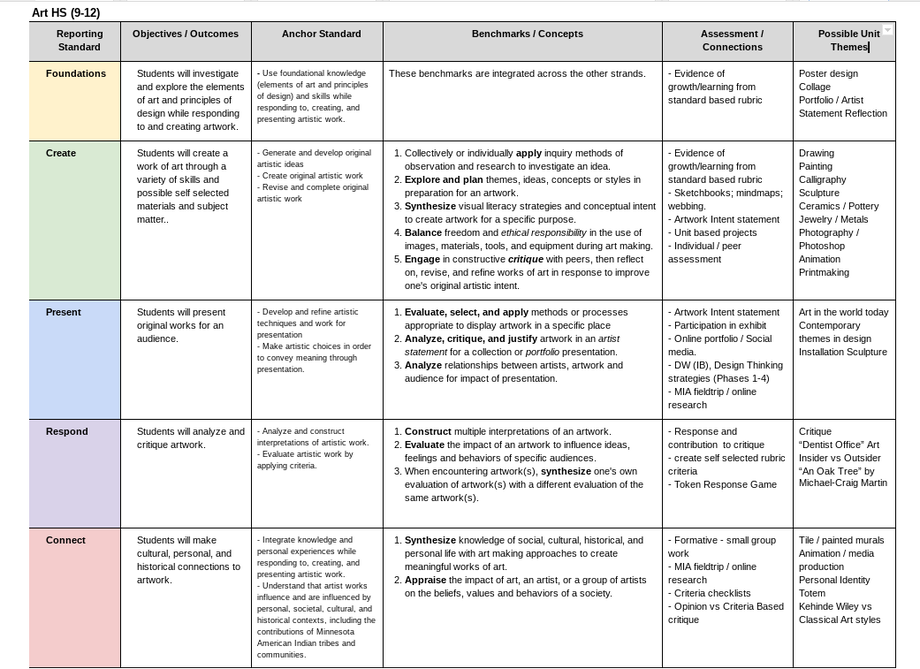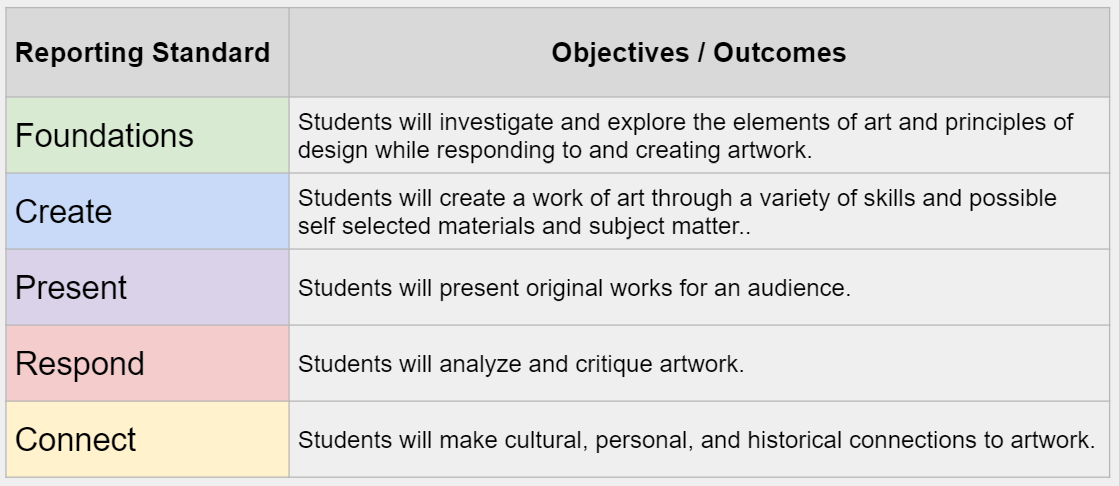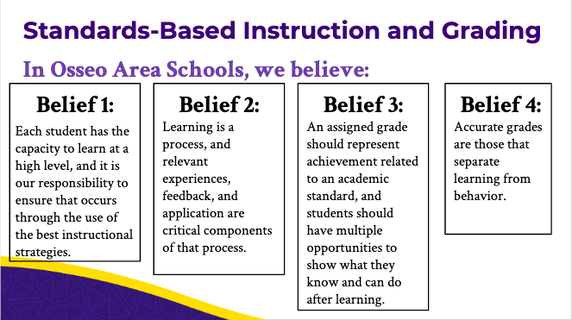Art, by its nature, is subjective. Every human being has a different aesthetic and sense of beauty; we all have a unique perspective and experience here on Earth. How does one viably evaluate, mark or grade something as art that is subjective? The MN Department of Education along with the National Arts Education Association has established MN Visual Arts Standards to help arts educators and students better understand how to evaluate arts related content in a more objective manner to foster growth in knowledge and skill for all students.
Current syllabus information will be the same for every visual arts course at Maple Grove Senior High with the exception of course descriptions, curriculum, and lists of materials.
MN Visual Arts Standards
Visual Arts: Grades 9 – 12
MN Visual Arts Standards
Visual Arts: Grades 9 – 12
District 279 Visual Art Reporting Standards
District 279 Osseo Area School's Visual Arts Reporting Standards will be documented in Schoology/Gradebook. Every summative assessment within the visual arts courses will be developed and filtered through these essential reporting standards. There are 5 reporting standards for our courses:
District 279 Osseo Area School's Visual Arts Reporting Standards will be documented in Schoology/Gradebook. Every summative assessment within the visual arts courses will be developed and filtered through these essential reporting standards. There are 5 reporting standards for our courses:
Standards Based Grading and Reporting
Too often students are penalized for making mistakes on assignments that are designed to help them develop and refine their skills before an assessment. If I assign homework or in-class assignments with the goal of helping students to practice (also known as Formative assessments) that work should not receive a grade that goes into a grade book. Instead, the goal of that work should be to help the student learn the material. Mistakes during practice should be celebrated as part of the learning process. If I penalize students who make mistakes while practicing a skill, I create an environment where mistakes are scary. This negatively impacts student motivation and can cause students unnecessary anxiety (Ask Yourself, Why Am I Grading This? Tucker, Catlin; Feb. 14 2019).
Evaluative Scoring: Points & Rubrics: All reported Summative assessments in Schoology / Gradebook will be given a mark of 0-4. The numbers are representative of achievement levels determined by rubric descriptors. The mark of 0-4 should not be considered "points". A student's learning is not an accumulation of points earned but a degree of understanding the concepts and contexts of the subject. Here is a simplified example of the criteria found on the project assessment rubrics:
Creativity & Originality
Quality & Craftsmanship
Application of Technique
Knowledge of Design
Process & Planning
Function & Presentation
4 - Mastery / Excellent - Showing exceptional growth or evidence of learning beyond the standard or beyond teacher expectation
3 - Competent / Proficient - Showing acceptable or adequate growth or evidence of learning to meet the standard.
2 - Basic / Almost - Showing vague or developing growth or evidence of partial learning to meet the standard.
Student work is evaluated holistically. Although a student may be developing in one area, he or she could exceed in another. We try to target the area that needs improvement. More than one mark may be entered as a definition in the Gradebook, however. Feedback will be provided in the comments section in Schoology.
Evaluations & Critiques: Students will participate in critique sessions and will self assess their own work. Students will evaluate their work against the rubric criteria before submitting their final product. Essentially, they will be grading themselves before teacher evaluations are given. Due to the subjectivity of evaluating artwork, there may be instances of evaluation marks between descriptor levels.
Grading Scale & Practices
A = 3.51-4.0 A- = 3.00-3.5
B+ = 2.84-2.99 B = 2.67-2.83 B- = 2.50-2.56
C+ = 2.34-2.49 C = 2.17-2.33 C- = 2.00-2.16
D+ = 1.84-1.99 D = 1.67-1.83 D- = 1.50-1.66
F = 0.00-1.49
Formative Assessments: Practice activities and assignments. These are daily assignments, in class or outside of school, that will be documented in Schoology with a score of 0-4. Formative assessments, if given an evaluative score, will be figured into 20% of the student's final grade. There will be formative assessments that may not have an accompanying score. Because formative assessments are considered practice, there may be instances where formative scores in Schoology will be canceled out if it misrepresents the summative calculation of the student's grade.
Summative Assessments: Summative assessments are the major projects associated with the end of a unit. These are to "test" the knowledge, skills, and techniques learned by the student. Summative assessments are weighed at 80% of the student's final grade. Summative assessments strictly reflect student achievement towards MN Visual Arts Reporting Standards.
Submission & Acceptance of Summative Assessment Tasks: Due dates for every assignment will be given with the project rubric. Work should be completed by the due date; however, art is subjective in nature and may require further attention beyond the due date depending on circumstances and effort towards the project. Quality work is desired over rushed work. All artwork will be accepted beyond the due date, but no later than the week before mid-tri and end-of-tri grade reporting. All work that is not turned in past the due date will have a report of "missing" or "work in progress" in the gradebook until the work has been viewed and evaluated.
Teacher Professional Judgment: The reality of grading and reporting, for all instructors in our district, is tied to a software, web-based, program known as Synergy Gradebook, or as parents and students know it as Parent or Student Vue. Scores entered in Gradebook are naturally averaged. This means that scores entered over the course of a trimester will be averaged in an output of a final grade that may or may not fully represent actual student achievement. During Mark Reporting (entering in grades for report cards) the instructor will make a professional judgment on each student's final grade that best represents that student's achievement throughout the trimester. The data entered for formative and summative scores will be utilized to make the best educated decision on a student's final grade. Additionally, over the course of a trimester, the latest summative score within a standard may be taken for a final grade submission while previous scores may be negated.
Re-assessment Policy
If a student is dissatisfied with his or her performance on an assessment they have two weeks to resubmit the assignment after assessment. Understanding that there are special circumstances outside of our control and that the resubmission deadlines can negotiated on a case to case basis. In order to redo the assessment they must demonstrate comparable skills achieved from formative work for that unit. Students summative work will not be punished or scored lower as a result of retaking or incompletion of all formative material.
Failure Policy
Students who fail, do not receive a grade, or let expire more than half of the summative assessments will not receive a passing grade.
Finals Week
For all of Mr. Nelsons' art classes, each trimester's finals week will require students to complete and show their knowledge and ability for creating an online, digital, portfolio that will showcase their work throughout the trimester. There are typically 2 summative scores associated with this art final: The overall Digital Portfolio grade and the Artist Reflection Statement (which accompanies the digital portfolio)
ALL WORK FOR THE TRIMESTER MUST BE SUBMITTED TO SCHOOLOGY BY 11:59 PM ON THAT LAST THURSDAY OF THE TRIMESTER BEFORE MARK REPORTING FRIDAY. NO WORK WILL BE ACCEPTED AFTER THAT TIME AND DATE.
Too often students are penalized for making mistakes on assignments that are designed to help them develop and refine their skills before an assessment. If I assign homework or in-class assignments with the goal of helping students to practice (also known as Formative assessments) that work should not receive a grade that goes into a grade book. Instead, the goal of that work should be to help the student learn the material. Mistakes during practice should be celebrated as part of the learning process. If I penalize students who make mistakes while practicing a skill, I create an environment where mistakes are scary. This negatively impacts student motivation and can cause students unnecessary anxiety (Ask Yourself, Why Am I Grading This? Tucker, Catlin; Feb. 14 2019).
Evaluative Scoring: Points & Rubrics: All reported Summative assessments in Schoology / Gradebook will be given a mark of 0-4. The numbers are representative of achievement levels determined by rubric descriptors. The mark of 0-4 should not be considered "points". A student's learning is not an accumulation of points earned but a degree of understanding the concepts and contexts of the subject. Here is a simplified example of the criteria found on the project assessment rubrics:
Creativity & Originality
Quality & Craftsmanship
Application of Technique
Knowledge of Design
Process & Planning
Function & Presentation
4 - Mastery / Excellent - Showing exceptional growth or evidence of learning beyond the standard or beyond teacher expectation
3 - Competent / Proficient - Showing acceptable or adequate growth or evidence of learning to meet the standard.
2 - Basic / Almost - Showing vague or developing growth or evidence of partial learning to meet the standard.
Student work is evaluated holistically. Although a student may be developing in one area, he or she could exceed in another. We try to target the area that needs improvement. More than one mark may be entered as a definition in the Gradebook, however. Feedback will be provided in the comments section in Schoology.
Evaluations & Critiques: Students will participate in critique sessions and will self assess their own work. Students will evaluate their work against the rubric criteria before submitting their final product. Essentially, they will be grading themselves before teacher evaluations are given. Due to the subjectivity of evaluating artwork, there may be instances of evaluation marks between descriptor levels.
Grading Scale & Practices
A = 3.51-4.0 A- = 3.00-3.5
B+ = 2.84-2.99 B = 2.67-2.83 B- = 2.50-2.56
C+ = 2.34-2.49 C = 2.17-2.33 C- = 2.00-2.16
D+ = 1.84-1.99 D = 1.67-1.83 D- = 1.50-1.66
F = 0.00-1.49
Formative Assessments: Practice activities and assignments. These are daily assignments, in class or outside of school, that will be documented in Schoology with a score of 0-4. Formative assessments, if given an evaluative score, will be figured into 20% of the student's final grade. There will be formative assessments that may not have an accompanying score. Because formative assessments are considered practice, there may be instances where formative scores in Schoology will be canceled out if it misrepresents the summative calculation of the student's grade.
Summative Assessments: Summative assessments are the major projects associated with the end of a unit. These are to "test" the knowledge, skills, and techniques learned by the student. Summative assessments are weighed at 80% of the student's final grade. Summative assessments strictly reflect student achievement towards MN Visual Arts Reporting Standards.
Submission & Acceptance of Summative Assessment Tasks: Due dates for every assignment will be given with the project rubric. Work should be completed by the due date; however, art is subjective in nature and may require further attention beyond the due date depending on circumstances and effort towards the project. Quality work is desired over rushed work. All artwork will be accepted beyond the due date, but no later than the week before mid-tri and end-of-tri grade reporting. All work that is not turned in past the due date will have a report of "missing" or "work in progress" in the gradebook until the work has been viewed and evaluated.
Teacher Professional Judgment: The reality of grading and reporting, for all instructors in our district, is tied to a software, web-based, program known as Synergy Gradebook, or as parents and students know it as Parent or Student Vue. Scores entered in Gradebook are naturally averaged. This means that scores entered over the course of a trimester will be averaged in an output of a final grade that may or may not fully represent actual student achievement. During Mark Reporting (entering in grades for report cards) the instructor will make a professional judgment on each student's final grade that best represents that student's achievement throughout the trimester. The data entered for formative and summative scores will be utilized to make the best educated decision on a student's final grade. Additionally, over the course of a trimester, the latest summative score within a standard may be taken for a final grade submission while previous scores may be negated.
Re-assessment Policy
If a student is dissatisfied with his or her performance on an assessment they have two weeks to resubmit the assignment after assessment. Understanding that there are special circumstances outside of our control and that the resubmission deadlines can negotiated on a case to case basis. In order to redo the assessment they must demonstrate comparable skills achieved from formative work for that unit. Students summative work will not be punished or scored lower as a result of retaking or incompletion of all formative material.
Failure Policy
Students who fail, do not receive a grade, or let expire more than half of the summative assessments will not receive a passing grade.
Finals Week
For all of Mr. Nelsons' art classes, each trimester's finals week will require students to complete and show their knowledge and ability for creating an online, digital, portfolio that will showcase their work throughout the trimester. There are typically 2 summative scores associated with this art final: The overall Digital Portfolio grade and the Artist Reflection Statement (which accompanies the digital portfolio)
ALL WORK FOR THE TRIMESTER MUST BE SUBMITTED TO SCHOOLOGY BY 11:59 PM ON THAT LAST THURSDAY OF THE TRIMESTER BEFORE MARK REPORTING FRIDAY. NO WORK WILL BE ACCEPTED AFTER THAT TIME AND DATE.



